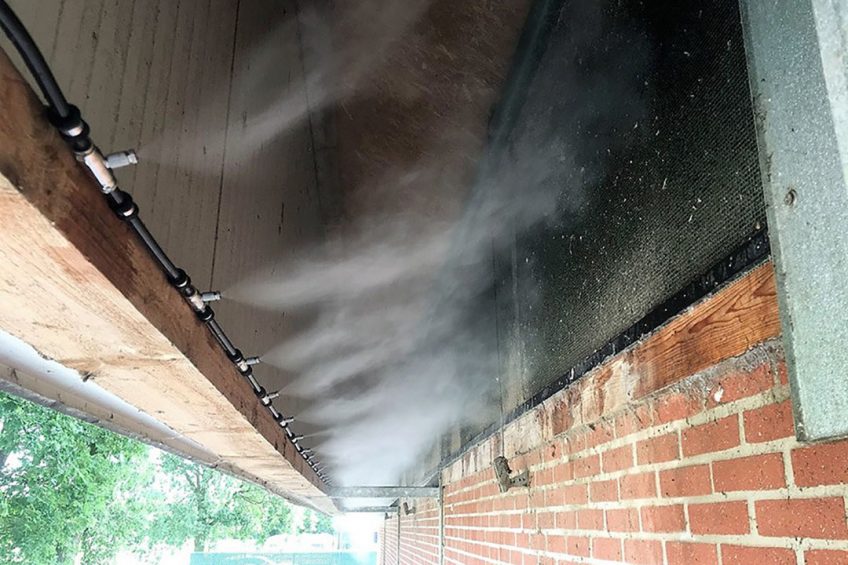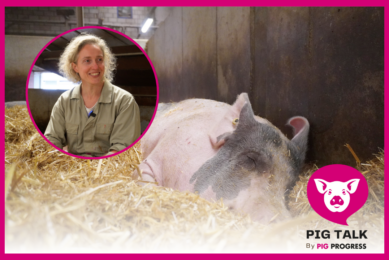Keeping pigs cool when temperatures spike

The EU PiG Innovation Group is a European partner network, aimed at sharing best practices and innovations in swine production. Every year, EU PiG heralds a number of ambassadors, whose innovations ended first in a Grand Prix. In this episode: high-pressure fogging.
The Ambassador
John van Paassen, owner of a farrow-to-finish pig farm in Deurne, the Netherlands. The farm has capacity for 440 sows and 2,750 finisher pigs.
The innovation
A high-pressure fogging system that reduces the temperature of incoming air by up to 8°C. Van Paassen had tubes with nozzles installed at the air inlets – which are powered by a high-pressure sprayer. The fog will cool down incoming air by up to 5%. Humidity levels can be adjusted for each pig house, as each type of pig thrives at different levels. The innovation won in the category ‘animal welfare – solutions for heat stress’.
The idea
In the Netherlands, in July 2019, temperatures went up to 41°C, which can easily lead to heat stress and affect production. In the context of global warming, such high temperatures are unlikely to be a one-off. According to van Paassen, even a short spell of very hot days could basically destroy a good annual result. Since he has various differently sized buildings, he was looking for a simple system that could be used in all his pig houses.
At van Paassen’s farm, the concept is an independent element of an overall climate control system, which also keeps temperatures constant in winter. The system works on the basis of a heat exchanger connected to the air scrubbers.
Advantages
- With temperatures in the range 36–40°C, a system like high-pressure fogging could result in fewer dead animals.
- A cooler environment ensures a continuous feed intake and fitter animals. EU PiG calculated that sows would have 0.8 piglets extra in the next litter, grow-finisher pigs would grow 50g/day extra and the feed conversion ratio would be lower by 0.1 if heat stress is reduced.
- The installation switches off automatically if the air becomes too humid.
- It can be installed in virtually every pig house.
The costs
The costs for the high-pressure fogging equipment depend on the size of the pig house. One-off investment costs are in the range € 1.50–€ 3.00 per finisher pig place and € 10–€ 20 per sow place. He says that the system has been implemented by hundreds of pig farmers in the Netherlands – there are various companies in the country offering technical support to have it installed.
Improvements?
Van Paassen says there are a few things that needed finetuning after installation. In some cases he had to close off a few nipples to make sure the right amount of fog would enter the room. Also, some nipples had to be replaced to be slightly smaller to match the requirements and sizes of the animals. Last but not least, he says, ventilation levels also have to be adjusted with the additional fog.
EU PiG Innovation Group
 The EU PiG Innovation Group (EU PiG) aims to help pig producers find tried-and-tested best practice from fellow producers across Europe. Through an annual EU-wide contest, called the EU PiG Grand Prix, more than 300 producers share their innovative ideas and best practices, which are developed in response to industry-wide challenges, to compete to become one of eight EU PiG ambassadors. Each year, two topics are chosen for each of the project’s four key themes, namely health management, meat quality, animal welfare and precision production. In this and the next seven editions of Pig Progress, one best practice will be discussed.
The EU PiG Innovation Group (EU PiG) aims to help pig producers find tried-and-tested best practice from fellow producers across Europe. Through an annual EU-wide contest, called the EU PiG Grand Prix, more than 300 producers share their innovative ideas and best practices, which are developed in response to industry-wide challenges, to compete to become one of eight EU PiG ambassadors. Each year, two topics are chosen for each of the project’s four key themes, namely health management, meat quality, animal welfare and precision production. In this and the next seven editions of Pig Progress, one best practice will be discussed.











